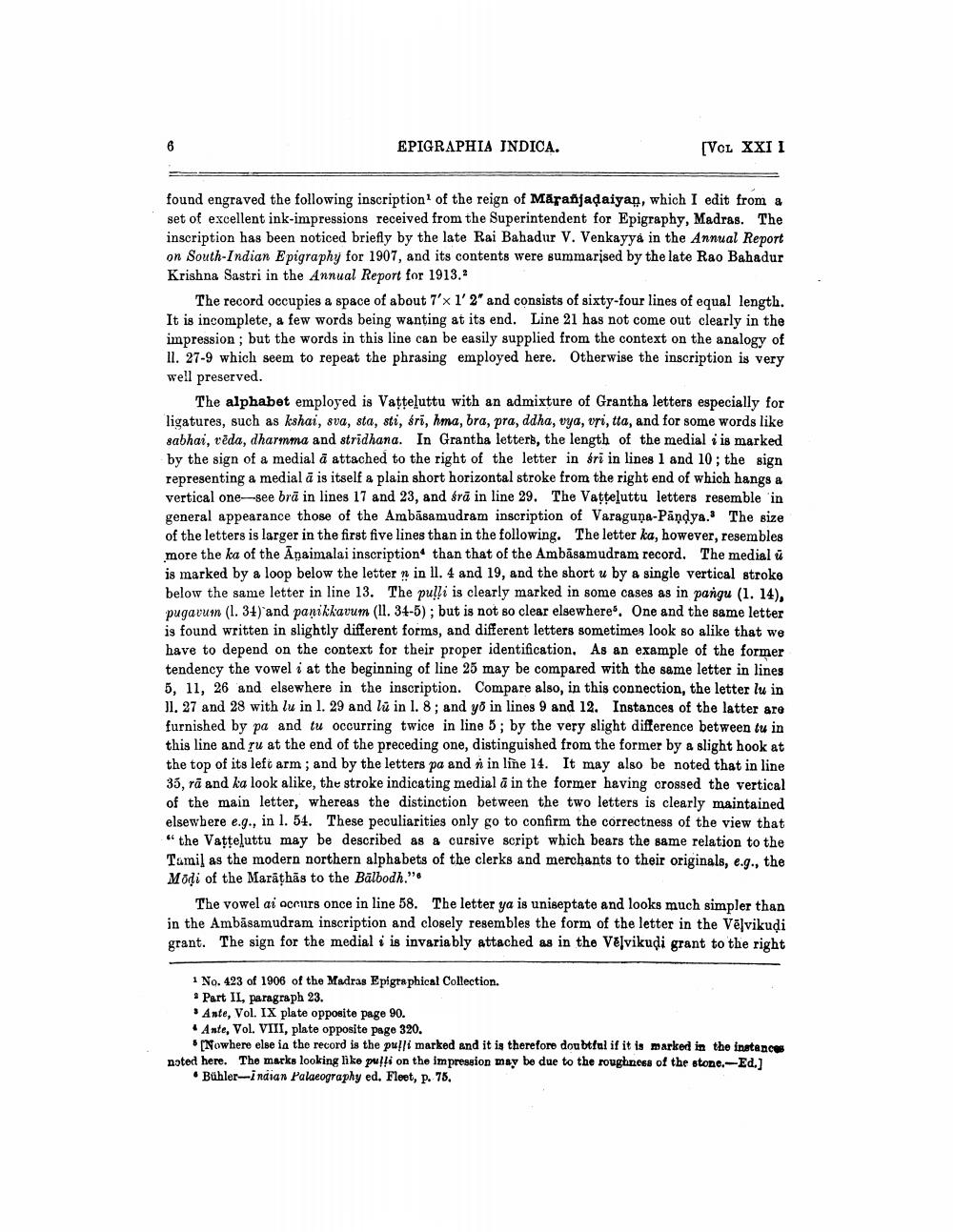________________
6
EPIGRAPHIA INDICA.
[VCL XXI I
found engraved the following inscription1 of the reign of Marañjaḍaiyan, which I edit from a set of excellent ink-impressions received from the Superintendent for Epigraphy, Madras. The inscription has been noticed briefly by the late Rai Bahadur V. Venkayya in the Annual Report on South-Indian Epigraphy for 1907, and its contents were summarised by the late Rao Bahadur Krishna Sastri in the Annual Report for 1913.2
The record occupies a space of about 7'x 1' 2" and consists of sixty-four lines of equal length. It is incomplete, a few words being wanting at its end. Line 21 has not come out clearly in the impression; but the words in this line can be easily supplied from the context on the analogy of 11. 27-9 which seem to repeat the phrasing employed here. Otherwise the inscription is very well preserved.
The alphabet employed is Vaṭṭeluttu with an admixture of Grantha letters especially for ligatures, such as kshai, sva, sta, sti, śrī, hma, bra, pra, ddha, vya, vri, tta, and for some words like sabhai, vēda, dharmma and stridhana. In Grantha letters, the length of the medial i is marked by the sign of a medial a attached to the right of the letter in śrī in lines 1 and 10; the sign representing a medial a is itself a plain short horizontal stroke from the right end of which hangs a vertical one-see bra in lines 17 and 23, and śra in line 29. The Vaṭṭeluttu letters resemble in general appearance those of the Ambasamudram inscription of Varaguna-Pandya.' The size of the letters is larger in the first five lines than in the following. The letter ka, however, resembles more the ka of the Anaimalai inscription than that of the Ambasamudram record. The medial u is marked by a loop below the letter n in 11. 4 and 19, and the short u by a single vertical stroke below the same letter in line 13. The pulli is clearly marked in some cases as in pangu (1. 14), pugavum (1. 34) and panikkavum (11. 34-5); but is not so clear elsewhere. One and the same letter is found written in slightly different forms, and different letters sometimes look so alike that we have to depend on the context for their proper identification. As an example of the former tendency the vowel i at the beginning of line 25 may be compared with the same letter in lines 5, 11, 26 and elsewhere in the inscription. Compare also, in this connection, the letter lu in 11. 27 and 28 with lu in 1. 29 and lu in 1. 8; and yo in lines 9 and 12. Instances of the latter are furnished by pa and tu occurring twice in line 5; by the very slight difference between tu in this line and ru at the end of the preceding one, distinguished from the former by a slight hook at the top of its left arm; and by the letters pa and n in line 14. It may also be noted that in line 35, ra and ka look alike, the stroke indicating medial a in the former having crossed the vertical of the main letter, whereas the distinction between the two letters is clearly maintained elsewhere e.g., in l. 54. These peculiarities only go to confirm the correctness of the view that "the Vaṭṭeluttu may be described as a cursive script which bears the same relation to the Tamil as the modern northern alphabets of the clerks and merchants to their originals, e.g., the Modi of the Maraāṭhās to the Balbodh."
The vowel ai occurs once in line 58. The letter ya is uniseptate and looks much simpler than in the Ambasamudram inscription and closely resembles the form of the letter in the Vēlvikuḍi grant. The sign for the medial i is invariably attached as in the Velvikudi grant to the right
1 No. 423 of 1906 of the Madras Epigraphical Collection.
Part II, paragraph 23.
Ante, Vol. IX plate opposite page 90.
Ante, Vol. VIII, plate opposite page 320.
[Nowhere else in the record is the pulli marked and it is therefore doubtful if it is marked in the instances noted here. The marks looking like pulli on the impression may be due to the roughness of the stone.-Ed.] • Bühler-Indian Palaeography ed. Fleet, p. 75.




